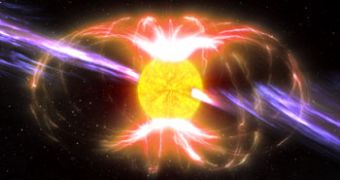Another space enigma has been solved by a team at the University of Arizona: what causes the powerful bursts from "magnetars", the most magnetic objects in space. These odd neutron stars are so superdense that the Sun's mass can be packed into a body which has the size of the Manhattan Island. Still, their magnetic fields are hundreds of trillions of times as powerful as Earth's and produce occasionally mysterious powerful bursts, spitting high-energy radiation waves across space.
Astronomers detected a magnetar with the NASA's X-Ray Timing Explorer in July 2003, when it shone 100 times its normal faint luminosity. They kept on monitoring it with the European Photon Imaging Camera (EPIC), on the European Space Agency's XMM-Newton Observatory until March 2006, when the object started to fade, signaling an imminent outburst. All this tine, EPIC observed shifts in the released X-ray amount.
The UA team introduced the changes of the magnetar's X-ray spectrum into a computer model to forecast its evolution, achieving a model showing the detailed physical qualities of a magnetar's surface and magnetic field. The results matched best with a model placing the outburst just below the surface of the magnetar, in an area about 3.5 km (2.2 mi) across.
"This is the first time both the surface emission and its subsequent reprocessing in the magnetosphere have been incorporated into the same computer model," said co-author Feryal Ozel, Assistant Professor of the UA physics and UA astronomy departments. "This is a breakthrough because we can now distinguish between surface and magnetospheric phenomena,'' said co-author Tolga Guver, visiting graduate student at the UA.
The new model also spectroscopically detected the force of this object's magnetic field: around 600 trillion times stronger than the Earth's, fitting an earlier calculation based on how rapidly the source is "spinning down," assessing change in the spin period over time.
"It is tremendously exciting to be able to compute exotic quantum phenomena that appear only in these ultrastrong magnetic fields and to see these predictions appear in actual data,'' said Ozel.
But the mechanism of the outburst, which must be somehow magnetically triggered, is still unknown.

 14 DAY TRIAL //
14 DAY TRIAL //